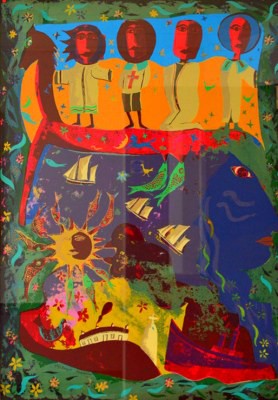
This piece, printed on Italian 280-gram Fabriano Rosaspina paper, takes advantage of silkscreen to create numerous colour separations. Martin spent his childhood in the fishing towns of Southeast Scotland and this piece, like most of his work, features a strong connection to the sea. The piece simultaneously has elements of the shore (in the buildings on the lower left), the open sea (the three sailing ships in the centre and the boat carrying the four figures at the top) and the sea depths (the floral border implies the sea floor).
Like most surreal artwork, the piece invites interpretation. It is unclear who the woman — if, indeed, it is a woman — on the far right is. from one angle she appears to be a fish swimming vertically up the painting, her nose forming a fin and her neck forming a tail. Her silhouette forms another face, perhaps unintentionally, of a woman with her eyes closed and a flower over her mouth. Could either of these figures be the 'Persephone' of the title? The name suggests an underworld motif, inviting the viewer to consider life under the surface, beneath the keel of the boat.
There are numerous charming little details to be found in this piece - the birds, fish and stars in the background behind the figures; the house and moon on the keel of the boat; the oversized bird next to the house in the bottom left.
The piece uses a broad colour palette to create contrast - compare the red skin of the figures in the boat with the blue sky. Yet the blues and greens tie everything together to reinforce the influence of the sea. The silkscreen stencils have allowed the artist to use elements repeatedly. This is best demonstrated by the flower border framing the image which is made from stencils of flowers and leaves.
There is repeated use of religious imagery, such as the church at the bottom, and the sailors on the boat that include a figure bearing the cross of a crusader (second from left) and the nimbus of a saint (far right). The three ships sailing across the surface in the centre is a common motif, recalling the three ships of Columbus's voyage and the traditional Christmas carol, 'I Saw Three Ships (Come Sailing In)'.
Martin Rayner was born in 1946 and grew up in North Berwick and Dunbar. After a diverse international career in journalism, he graduated from the Duncan of Jordanstone College of Art and Design in Dundee in 1981. His work can be found in numerous international private collections as well as the Scottish Arts Council, the Duke of Atholl and the City Council of Wurzburg, Bavaria. His awards include the Major Award from Scottish Arts Council and the Hope Scott Trust Travel Award to Chicago. He has worked as a visiting lecturer throughout Scotland and the UK.
NHS Fife recognises the importance that art plays in creating an environment conducive to good health and well being. Our collection of artwork is intended to be enjoyed by patients, their visitors and staff alike.
Contact Mark McGeachie, Fife Health Charity via email on fife.healthcharity@nhs.scot.